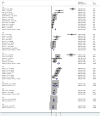Drug-Resistant Tuberculosis Among Children: A Systematic Review and Meta-Analysis
- PMID: 34490197
- PMCID: PMC8416474
- DOI: 10.3389/fpubh.2021.721817
Drug-Resistant Tuberculosis Among Children: A Systematic Review and Meta-Analysis
Abstract
Background: Drug-resistant tuberculosis (DR-TB), especially multidrug-resistant tuberculosis (MDR-TB) is a public health threat. Little is known about estimates of different profiles and rates of DR-TB among children globally. Methods: We did a systematic review and meta-analysis of observational studies reporting DR-TB among children by searching Embase, PubMed, and Scopus databases from January 1, 2000 to October 1, 2020. Publications reporting more than 60 children with bacteriological confirmed tuberculosis and phenotypical drug susceptibility testing (DST) results were included. Pooled proportions of MDR-TB and sub-analysis by age subgroups, regions, economical levels were performed. Results: We identified 4,063 studies, of which 37 were included. Of 23,652 pediatric TB patients, the proportions of DR-TB, MDR-TB, mono-resistant TB, polydrug resistant TB, extensively drug-resistant TB were 13.59% (1,964/14,453), 3.72% (881/23,652), 6.07% (529/8,719), 1.61% (119/7,361), 0.44% (30/6,763), respectively. The pooled proportion of MDR-TB among 23,652 children of 37 studies was 3.7% (95% CI, 3.5-4.0%). Rate of MDR-TB was much lower in high-income countries (1.8%) than that in lower-middle-income countries (6.3%) and upper-middle-income countries (7.3%). More specifically, the rates of MDR-TB were 1.7% in USA, 1.7% in UK, 2.9% in India, 6.0% in South Africa, 9.8% in China, respectively. Conclusions: The burden of DR-TB remains high in children, and there are potential associations between rates of pediatric MDR-TB and national economical levels. More interventions on child TB cases in low-income countries may be urgently needed in future.
Keywords: children; drug resistance; meta-analysis; national economic levels; tuberculosis.
Copyright © 2021 Song, Li, Liu, Liu, Yu, Liu and Li.
Conflict of interest statement
The authors declare that the research was conducted in the absence of any commercial or financial relationships that could be construed as a potential conflict of interest.
Figures







Similar articles
-
Evolving rifampicin and isoniazid mono-resistance in a high multidrug-resistant and extensively drug-resistant tuberculosis region: a retrospective data analysis.BMJ Open. 2019 Nov 6;9(11):e031663. doi: 10.1136/bmjopen-2019-031663. BMJ Open. 2019. PMID: 31699736 Free PMC article.
-
Multi-Drug Resistant and Extensively-Drug Resistant Tuberculosis.Indian J Pediatr. 2020 Oct;87(10):833-839. doi: 10.1007/s12098-020-03230-1. Epub 2020 Feb 26. Indian J Pediatr. 2020. PMID: 32103425 Review.
-
Prevalence and patterns of drug resistant pulmonary tuberculosis in India-A systematic review and meta-analysis.J Glob Antimicrob Resist. 2020 Sep;22:308-316. doi: 10.1016/j.jgar.2020.03.008. Epub 2020 Apr 1. J Glob Antimicrob Resist. 2020. PMID: 32247079
-
HIV infection and multidrug resistant tuberculosis: a systematic review and meta-analysis.BMC Infect Dis. 2021 Jan 11;21(1):51. doi: 10.1186/s12879-020-05749-2. BMC Infect Dis. 2021. PMID: 33430786 Free PMC article.
-
Bedaquiline safety, efficacy, utilization and emergence of resistance following treatment of multidrug-resistant tuberculosis patients in South Africa: a retrospective cohort analysis.BMC Infect Dis. 2022 Nov 21;22(1):870. doi: 10.1186/s12879-022-07861-x. BMC Infect Dis. 2022. PMID: 36414938 Free PMC article.
Cited by
-
Diagnostic value of tNGS vs Xpert MTB/RIF in childhood TB.Heliyon. 2023 Dec 3;10(1):e23217. doi: 10.1016/j.heliyon.2023.e23217. eCollection 2024 Jan 15. Heliyon. 2023. PMID: 38148816 Free PMC article.
-
Multidrug-resistant tuberculosis in children: A practical update on epidemiology, diagnosis, treatment and prevention.J Clin Tuberc Other Mycobact Dis. 2024 May 1;36:100449. doi: 10.1016/j.jctube.2024.100449. eCollection 2024 Aug. J Clin Tuberc Other Mycobact Dis. 2024. PMID: 38757115 Free PMC article.
-
Health inequalities in infectious diseases: a systematic overview of reviews.BMJ Open. 2023 Apr 4;13(4):e067429. doi: 10.1136/bmjopen-2022-067429. BMJ Open. 2023. PMID: 37015800 Free PMC article.
-
The burden of tuberculosis among adolescents and young adults in five Asian countries from 1990 to 2019.Arch Public Health. 2023 Aug 8;81(1):143. doi: 10.1186/s13690-023-01160-w. Arch Public Health. 2023. PMID: 37553708 Free PMC article.
-
Treatment of drug-resistant tuberculosis in children and young adolescents in Brazil.J Clin Tuberc Other Mycobact Dis. 2023 Aug 2;33:100388. doi: 10.1016/j.jctube.2023.100388. eCollection 2023 Dec. J Clin Tuberc Other Mycobact Dis. 2023. PMID: 37588725 Free PMC article.
References
-
- WHO . Global Tuberculosis Report. (2020). Available online at: https://www.who.int/publications/i/item/9789240013131 (accessed July 14, 2021).
-
- Ködmön C, van den Boom M, Zucs P, van der Werf MJ. Childhood multidrug-resistant tuberculosis in the European Union and European Economic Area: an analysis of tuberculosis surveillance data from 2007 to 2015. Euro Surv Bull Eur sur les Maladies Trans Eur Commun Dis Bull. (2017) 22:17–00103. 10.2807/1560-7917.ES.2017.22.47.17-00103 - DOI - PMC - PubMed
Publication types
MeSH terms
Substances
LinkOut - more resources
Full Text Sources

